Well, time travelers, I'm off to the 18th century! This is my absolute favorite time to visit and study because if I could, I would dress like Marie Antoinette every single day. The colors, textures, and motifs are simply HEAVENLY!
 |
| I just wanna like, BE HER! |
ROCOCO
 |
| Marie Antoinette, THE fashion icon of the 18th century |
So, Baroque was cool and all, but ROCOCO is the ULTIMATE. Rococo was lighter, softer, more delicate, and smaller. Fashion was light and fluffy and flamboyant, which is why it is my favorite.
 |
| WIDER, you say?! |
The biggest thing to note in the change in fashion is the WIDENING silhouette for men and women.
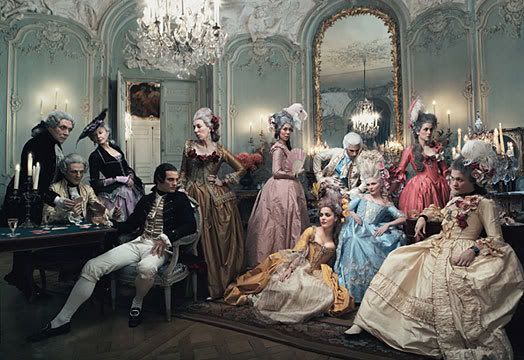 |
Great examples of Rococo fashion. |
 |
| The mantua. Gorgeously embroidered, adorned with pastel ribbons |
For example, in the early century, the mantua was very popular for formal occasions. Women wore this open-front dress with a matching petticoat and the train was looped over the hips to show the petticoat. The sleeves were loose and stopped at the elbow with wide cuffs. These dresses were made of silk or fiiiine wool were often embroidered with silk and metallic thread. A HOOP petticoat or pannier was worn with this dress, along with several UNDER-petticoats to create more width.
 |
| Watteau you talking about? |
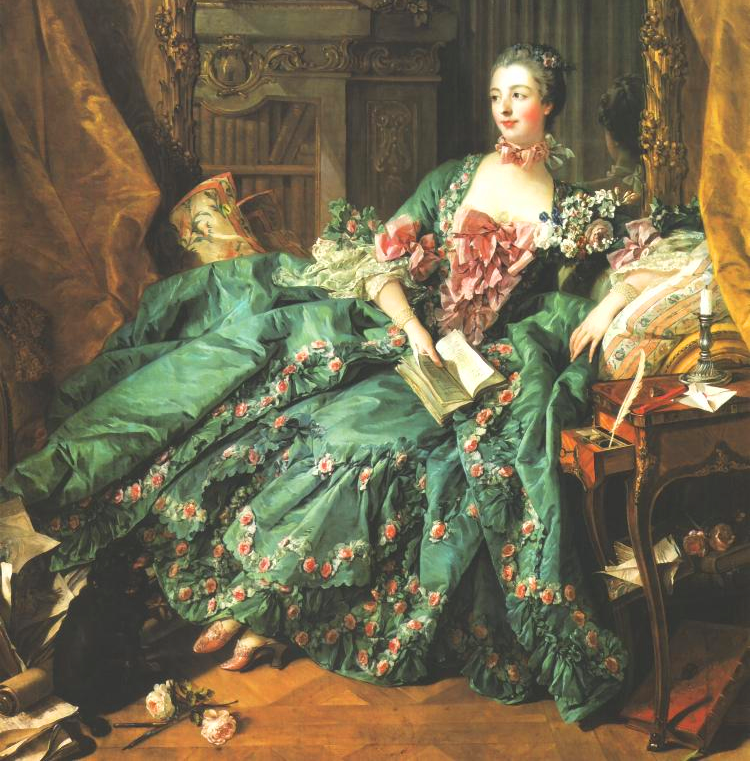 A watteau back dress was made from 5 or 6 panels box pleated at the back of the neck. This dress, too, was worn over a matching petticoat and a hoop petticoat or pannier.
A watteau back dress was made from 5 or 6 panels box pleated at the back of the neck. This dress, too, was worn over a matching petticoat and a hoop petticoat or pannier.
Fabrics were luscious and pastel. Lightweight taffeta, satin, and damask were used to make gowns and other garments. These light silks were beautiful pastel colors such as pink, blue, yellow, and lavender and featured small floral motifs, stripes, embroidery, or were left solid.
Women's fashion of the Rococo period was marked by the PANNIER. This provided support for the overly-dramatic widening of the hips on women's gowns. The pannier was supported by a frame of wood, cane, whalebone, or metal. The pannier helped extend out the skirt of the petticoat itself as well as the skirt of the robe or gown the woman was wearing. It is called a pannier because it resembled chicken baskets. IMAGINE THAT!
 |
| Marie Antoinette and her ladies wearing straw hats and perfect Rococo fabrics |
Another typical woman's Rococo garment was the robe à la française. The gown opened in the front and had large pleats in the back. It was of course worn with a pannier and a corset.
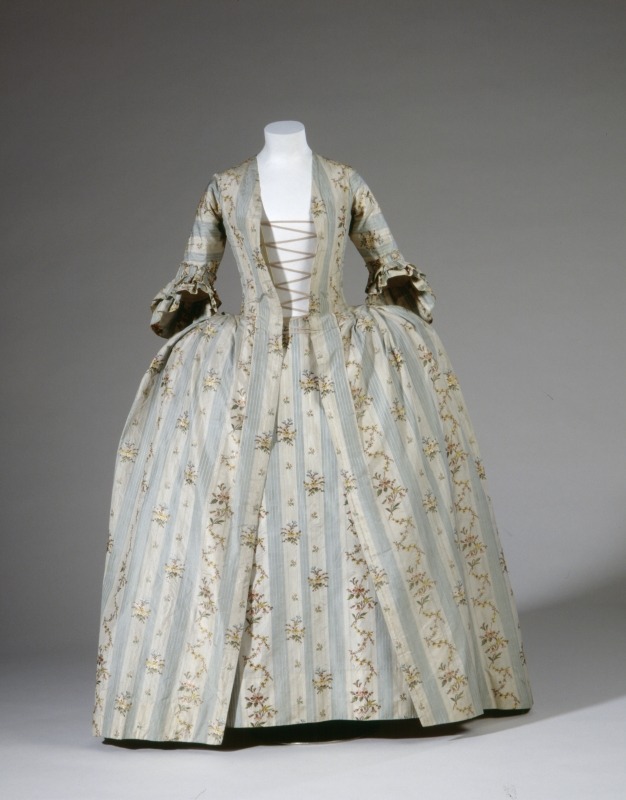
 |
| The robe a l'anglaise |
The robe à l'anglaise was also an open robe with a bodice cut in one piece with an overskirt that parted to reveal the matching petticoat, OF COURSE. This one did not have back pleats, but an all-around fitted bodice.
 |
| Uncomfortable but fun silky Rococo shoes |
 |
| You werque that hair, girl |
Ladies wore wigs on special occasions but mostly wore their own hair, especially powdered, curled, piled high, and decorated with little bows, flowers, jewelry, and trinkets. The use of makeup was a bit more modest. Rococo women had several different hats and bonnets, such as the pinner, the mob cap, and the straw hat.
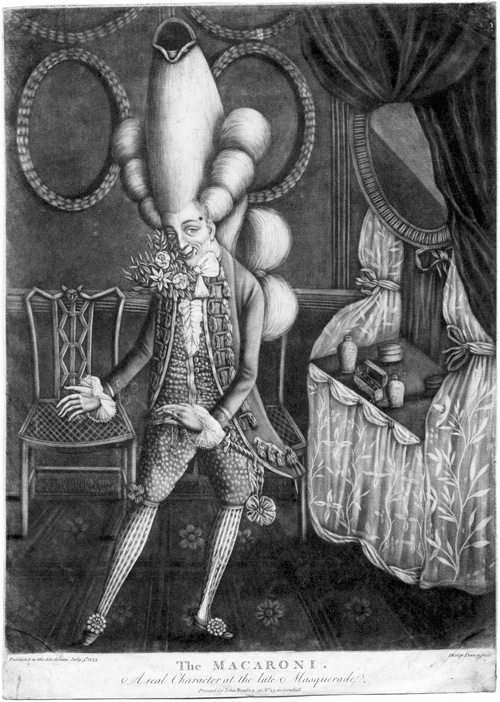
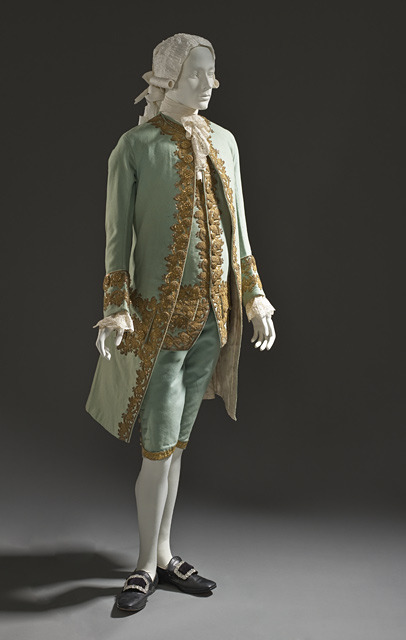 |
| Example of men's Rococo fashion |
Men's fashion didn't change much in shape. A man would wear knee-length breeches that were closer-fitting and buckled below the knee long with his silk stockings. Rococo men wore buttoned vests and collared or collarless waistcoats. The frock coat was looser fitting and less stiff with interfacing. Coats could feature large sleeve cuffs or no cuffs and some coats had several pleats in the back. Shoes were heeled and leather with rounded toes. Unlike the women, men were wearing marvelous wigs and topped them off with tricorn hats.
GEORGIAN
Guess what? Forget almost everything you know about fashion in the 18th century. Everything is going to start changing very quickly from now on.
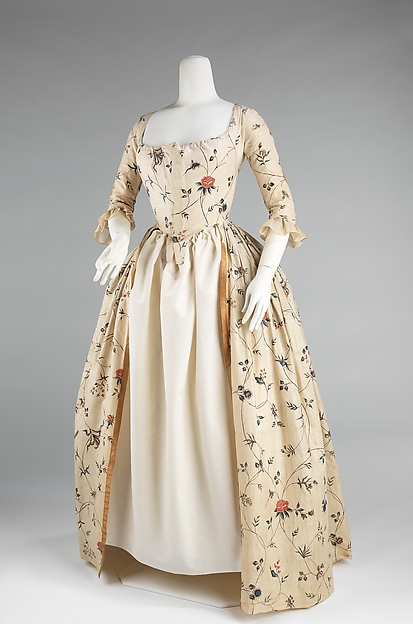 |
| A more relaxING robe a l'anglaise |
Fashion periodicals were influencing women to wear more simplistic fashion. Women's dresses were certainly becoming more appropriate during these revolutionary times and women were wearing riding habits and redingotes. The waist got higher and understructures were simplified. Fabrics that became more popular in women's fashion were linen, cotton, and woolen cloth in similar colors from the Rococo period. In France especially, women were urged to wear French fabrics like woolen cloth and cotton. The robe à l'anglaise stuck around for a long time and became the exemplification of simple English aesthetic.
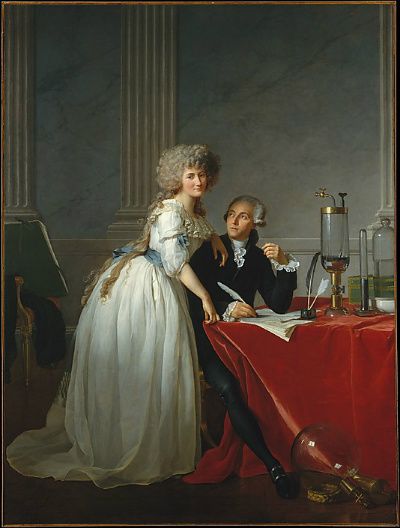 |
| "No, it's not a nightgown!" |
 |
| "I'm so egalitarian!" |
In the late 18th century, sweet little Marie Antoinette donned a chemise a la reine or chemise gown. Of course, it was still pastel and light but this little gown had an empire waist, required no understructure, and was made of COTTON. People considered it immodest and weird but Marie was WAY ahead of the game. Like, 20 years actually. The chemise la reine was worn because of its light, inexpensive fabrics, simple silhouette, and construction. It was all about cost and the Revolution!
 |
| Much better, men! |
 |
| Why yes, it is a tailcoat. |
Men's clothing was becoming more sleek and fitted and was also losing some of its flamboyancy. Sleeve cuffs shortened a great deal and the coat skirts shrunk in bulk. This change in men's fashion gave a more elegant and handsome look. The skirts of coats started sloping back, slowly so far back that the tailcoat was born.






 A watteau back dress was made from 5 or 6 panels box pleated at the back of the neck. This dress, too, was worn over a matching petticoat and a hoop petticoat or pannier.
A watteau back dress was made from 5 or 6 panels box pleated at the back of the neck. This dress, too, was worn over a matching petticoat and a hoop petticoat or pannier.
















Extraordinary how people then took pride with their garments and mannerisms..miss the good old days.. The women then were awesome!
ReplyDelete